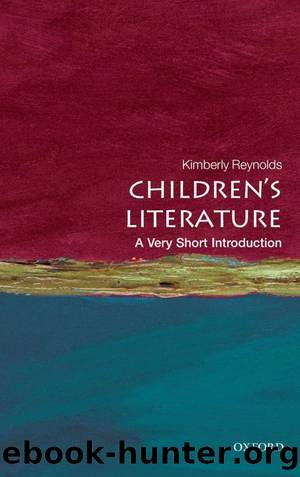Children's Literature: A Very Short Introduction by Kimberley Reynolds

Author:Kimberley Reynolds [Reynolds, Kimberley]
Language: eng
Format: epub
ISBN: 9780199560240
Publisher: Oxford University Press
Published: 2011-01-15T07:00:00+00:00
The three Is: interactivity, interpersonality, and immersion
Childrenâs first encounters with stories as part of transmedia chains usually begin with television programmes such as Sesame Street, Bob the Builder, or In the Night Garden. The programmes introduce them to characters, setting, and a selection of stories, and are extended through websites that offer activities including read-along stories that resemble conventional picture books: children hear a story and can also see the printed text, which changes colour as each word is spoken. Although similar to picture books, these onscreen versions are likely to include animation, sound, and some hypertext links that allow children to interact with the text by touching or clicking.
The networks include a wide range of products, including DVDs of the television programmes and specially made films, interactive books, computer games, and toys. While they can be enjoyed separately, many are designed to be used in combination, increasing the potential for interaction while creating incentives to buy more products in the network. So, for example, a Bob the Builder doll may incorporate a handset that is linked to a Bob the Builder book; pushing a number prompts Bob to speak phrases that complement the corresponding page in the book. The claims for these transmedia networks show how traditional literacy skills are blending with other kinds of learning and entertainment. For example, in addition to teaching such familiar skills as number, letter, and colour recognition, Button Sound Books, producers of a range of Bob the Builder books and linked products, promise that their young users will also âlearn how to use a microphone, a camera, and how to play the piano and guitarâ! These first-stage transmedia networks demonstrate two key elements of transmediality: they are interactive and, because young children require adult help with various aspects of accessing and using the texts, they have an intrinsic interpersonal dimension. Interpersonality is extended if more than one child is participating; Mackey (2010) has shown that children can work together on such texts, transferring decoding and problem-solving skills learned from picturebooks and computer games between the two media. For older children, interpersonal elements are normally experienced through games and online forums that are designed for multiple users.
A third element of transmediality is immersion, usually used to describe the level of involvement of someone playing a computer game. Immersion is an equally valid way of describing the experience of being âlost in a bookâ, however, and examining the ways in which transmedia chains may enhance or disrupt immersion reveals the extent to which they can complement the reading of conventional, print-based materials. Being fully immersed in a book or film or game is pleasurable, but it is often regarded as a state in which the critical faculties are suspended. The first encounter with a text in a transmedia network is likely to produce a high degree of immersion, but once âreadersâ start to move across the network and participate in ongoing discussions about the different manifestations of the text, satisfaction comes from studying, questioning, and
Download
This site does not store any files on its server. We only index and link to content provided by other sites. Please contact the content providers to delete copyright contents if any and email us, we'll remove relevant links or contents immediately.
Machine Learning at Scale with H2O by Gregory Keys | David Whiting(4200)
Never by Ken Follett(3801)
Fairy Tale by Stephen King(3230)
Reminders of Him: A Novel by Colleen Hoover(2954)
Oathbringer (The Stormlight Archive, Book 3) by Brandon Sanderson(2907)
Will by Will Smith(2797)
Once Upon a Broken Heart by Stephanie Garber(2690)
Fantastic Beasts and Where to Find Them: The Original Screenplay by J. K. Rowling(2471)
Never Lie: An addictive psychological thriller by Freida McFadden(2369)
The Dark Hours by Michael Connelly(2246)
Can't Hurt Me: Master Your Mind and Defy the Odds - Clean Edition by David Goggins(2230)
Friends, Lovers, and the Big Terrible Thing by Matthew Perry(2127)
The Becoming by Nora Roberts(2095)
Principles for Dealing With the Changing World Order: Why Nations Succeed and Fail by Ray Dalio(1975)
Love on the Brain by Ali Hazelwood(1967)
The Complete Witcher by Andrzej Sapkowski(1797)
The Strength In Our Scars by Bianca Sparacino(1780)
Cytonic by Brandon Sanderson(1779)
A Short History of War by Jeremy Black(1764)
